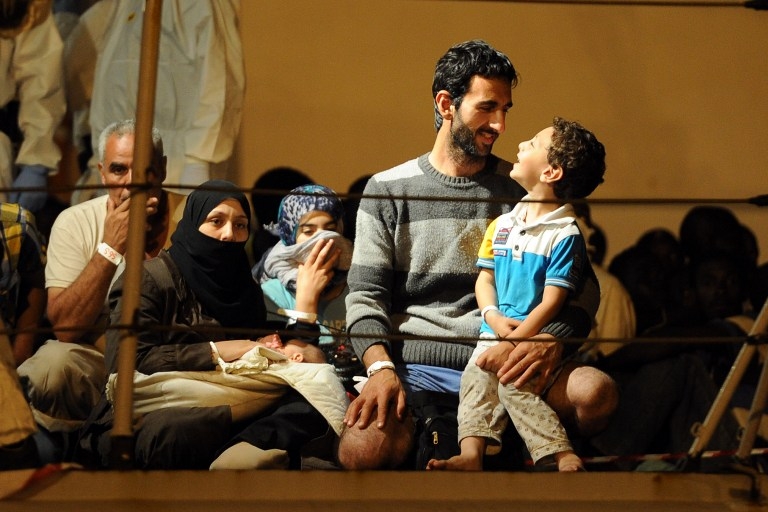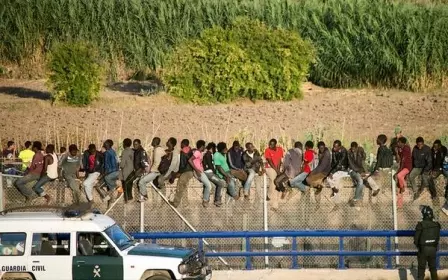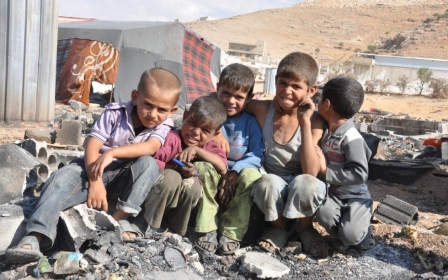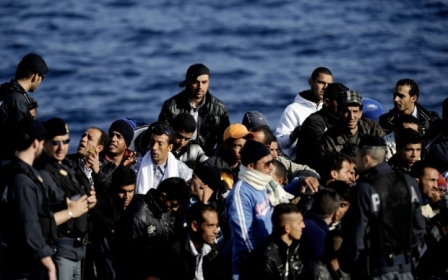Preparing for 'a death trip': the story of one Syrian refugee

On a late-summer morning in northern Jordan, as the sun rose over the city of Irbid, perched high on a desert ridge, a young father prepared to die at sea.
He packed a bag, just the barest essentials - two pairs of trousers, two shirts, a spare pair of shoes, gaffer tape, money and his passport - and kissed his wife goodbye. Goodbye for months, for a year, maybe forever.
His children, a shy, watchful five-year old boy and a bright-eyed, studious seven-year old girl, didn’t fully understand what was happening. Baba was leaving. Going to Europe for a better life, but it was dangerous. He called it “a death trip.”
The tears, the last looks and touches, and then he was gone.
Swallowed into a swarm of people surging north to Europe, and the sinister business of getting them there as cheaply as possible.
Swallowed into unstable, warring Libya, where he was afraid bandits would take his money, which he planned to hide in his shoes.
Swallowed, maybe, into the sea.
Thousands arriving each week
“More than 110,000 people have arrived in Italy so far this year, sometimes 4,000 or even 5,000 people in a matter of days,” said Flavio Di Giacomo, spokesman for the International Organisation for Migration (IOM) in Italy.
“A single Italian Coast Guard ship can rescue up to 1,300 migrants in a day, all of them coming to one entry point - Sicily,” he said.
IOM is working with the Italian authorities, the United Nations refugee agency, UNHCR, Save the Children and the Italian Red Cross to cope with the seemingly endless flow of humanity surging across the Mediterranean in search of what so many of them describe as “a better life.”
In the first seven months of 2014, more than 16,000 Syrians washed up in Italy, half of them men and nearly 5,000 of them children.
These numbers are part of a steep upward trajectory: in all of 2013, Frontex, the agency responsible for the EU's external borders, counted just 9,591 Syrians crossing the Mediterranean to Italy and Malta.
Unlike the sub-Saharan Africans on these boats who are fleeing war directly, most Syrians come from second countries where their biggest problem isn’t war, but the limbo of refugee life, where they are forbidden from working and forced to rely on fast-depleting savings and overstretched NGOs.
The father from Irbid ran a construction supply company in Syria, and his wife worked as a midwife. They had two incomes, a home, a car. And then, suddenly, they were refugees and they had nothing. Like the Africans, the Afghans, the Pakistanis and so many others on these boats, the father from Irbid is chasing dreams of a liveable wage, a comfortable home, schools for his kids and a community where his family is welcome.
He prefers to remain anonymous because he fears he will be tracked by Jordanian security, refused entry to Europe and sent to either Turkey or Lebanon where he won't be able to reunite with his wife and kids.
The upshot of the risky journey he is about to take isn’t completely clear: Europe is experiencing a well-documented swing to the right, politically, and both refugees and economic migrants are less welcome now than they have been in the past. If migrants make it to Europe, they must still make it in Europe. And there’s no reliable data yet on how many Mediterranean migrants have managed to make their European dreams come true.
But the possibility of a better life and the rumours that colour those dreams - the father from Irbid was convinced that any European country would offer him “food, a place to live, school for my kids and a job for me” - keep people coming, despite the most obvious risk: not making it at all.
Fresh in his mind was the stretch of days in July when the sea should have turned black in mourning, so many lives had been lost. During these darkest days, UN High Commissioner for Refugees António Guterres called for urgent action from across Europe: "The death of 260 people in less than ten days, in the most horrifying of circumstances, is evidence that the Mediterranean crisis is intensifying."
But the crisis continues to intensify, and now the father from Irbid was about to become part of it. If he made it to Italy, he would float over those 260 graves.
IOM estimates there have been more than 1,500 deaths so far this year among migrants bound for Italy, but Di Giacomo called this a “very, very optimistic” estimate.
UNHCR says the number is even higher: it counts 1,889 migrants dead at sea in 2014, 1,600 of them since the beginning of June.
Migrants rescued from rammed, decrepit fishing boats by the Italian Coast Guard’s Mare Nostrum (Our Sea) operation, describe people dying of illness or thirst or exposure and their bodies being thrown overboard. Some speak of sister ships that left Libya alongside theirs, but never made it.
“We know how many arrive, but we will never know how many people left,” said Di Giacomo.
Trafficking: A business where people are money
Drowning in the Mediterranean was at the top of the father from Irbid’s list of fears. He had heard that the lifejackets issued by traffickers were made of cork, and he planned to buy a rubber tyre filled with air when he arrived in Libya.
But Di Giacomo, who has worked backwards from migrants’ point of entry in Europe and mapped the threats and status quos on the roads that lead there, said lifejackets aren’t issued as a matter of course: migrants must pay extra, typically between $50 and $100 USD, and sub-Saharan migrants, regarded by traffickers as inferior, are not permitted to buy them.
As for the rubber tyre, space is at such a premium on these overloaded vessels that it’s unlikely any passenger would be permitted to carry something that, if jettisoned, might allow another person on board. In this business, people are money.
How much money depends on the route. The father from Irbid had been told his journey would cost $4,000 USD, but Di Giacomo said this was too low: “He’ll be asked for more money once he’s en route.”
That route would take the father from Amman to Algeria by plane, with a handful of other Syrian migrants, and then as part of a larger group, by bus to Tunisia and on to Libya. Every border crossing would be covert, every checkpoint a risk.
“If I get arrested while crossing to Libya they’ll put me in jail and then send me to Lebanon or Turkey. I won’t be able to come back to Jordan to my family, because Jordan won’t let me come back unless I have a resident visa from a Gulf or European country,” said the father.
If the father and his fellow migrants make it to Libya - dangerously unstable and edging closer to the kind of war he fled in Syria - Di Giacomo said they would eventually be sent to what is known as a connection house, where traffickers gather migrants, extract payment and hold boatload-sized groups until it’s time to go.
IOM has documented testimony from numerous migrants about this point in the journey, where traffickers tighten the chain around their victims. In one Nigerian migrant’s words, “Once you have paid you can’t go back.”
Viewing asylum through rose-tinted glasses
Back in Irbid, hundreds of miles from the Mediterranean and four nights before the young father would set off, his own father shook his head slowly as he counted his sons: seven young men, now in five countries. A refugee himself, his own dreams dashed, he couldn’t, or wouldn’t, stop him.
“This is an experience my son wants to have. What can I do?” he asked.
And what could he do? The son who was packing his bag and preparing his children wasn’t the first to take this risk: several months before, his younger brother, a doctor, had survived the crossing and made it to Germany.
The young man was finding his feet as a refugee, but his parents, cousins and brothers in Jordan believed he would have the opportunity to complete his residency and live what they all yearned for: a normal life. It was too soon to say, but hope - amplified by a stubborn, rose-tinted understanding of how refugees are received in Europe - was a powerful thing.
IOM statistics indicate that many migrants, and especially Syrian migrants, are trying to reach family members already living in Europe.
UNHCR data shows that Syrian asylum-seekers are mainly concentrated in Sweden and Germany, receving 56 percent of all Syrian asylum applications. Bulgaria, Switzerland and the Netherlands are also popular destinations.
When they arrive in Italy, migrants are admitted to reception centres, where they are checked for health problems and specific vulnerabilities - any unaccompanied children are identified and taken into care, for example - and given a shower, food and place to sleep.
But these centres are not prisons: migrants are free to leave, and most know - through the same word of mouth network that assures them they will be offered a home and a job in Europe - that the European country they are fingerprinted and registered in will be the one that hears their claim of asylum. Those migrants heading for family members in Germany, as the father from Irbid is, or rumours of an open-armed welcome by the Swedish welfare system, tend to skip town before registration happens, Di Giacomo explained.
“When we had fewer migrants, we could process them in hours or at least in the same day. But now, with so many people arriving, it takes a few days,” he said.
With clear data pointing to family reunification as a major driver behind so many journeys into the Mediterranean, Di Giacomo thinks the onus must be on European countries to reconsider their family reunification policies and offer “safe and legal” entry points.
“The humanitarian emergency isn’t the number of people arriving, but the way they arrive,” said Di Giacomo. “We can’t have this in the 21st century, children dying at sea trying to reach the Italian coasts.”
Middle East Eye propose une couverture et une analyse indépendantes et incomparables du Moyen-Orient, de l’Afrique du Nord et d’autres régions du monde. Pour en savoir plus sur la reprise de ce contenu et les frais qui s’appliquent, veuillez remplir ce formulaire [en anglais]. Pour en savoir plus sur MEE, cliquez ici [en anglais].




